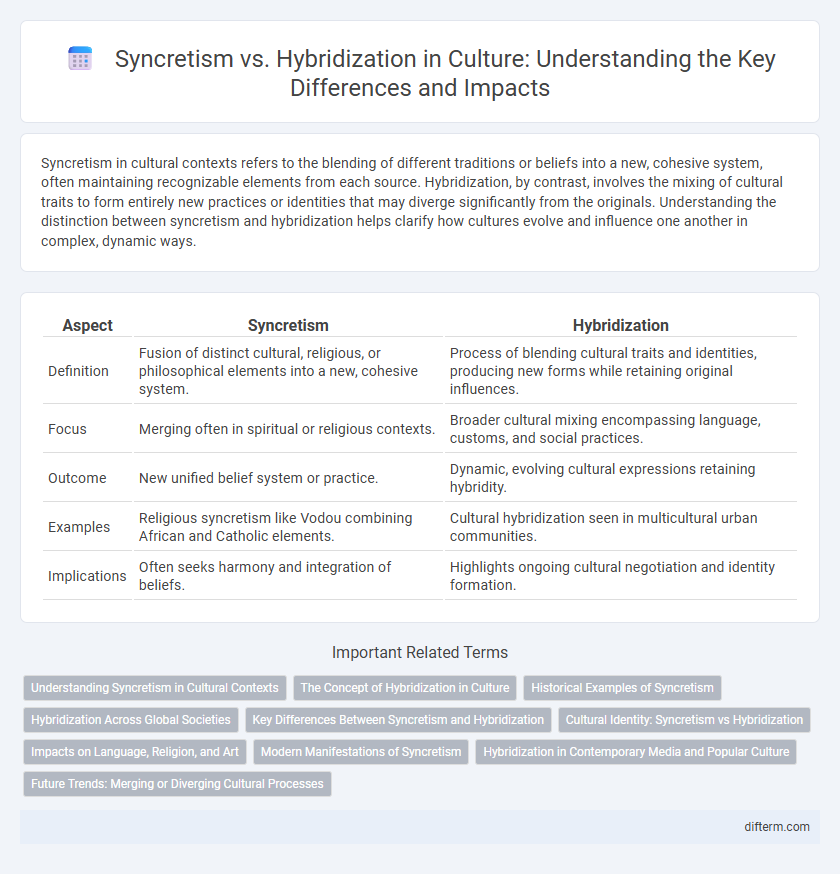Syncretism in cultural contexts refers to the blending of different traditions or beliefs into a new, cohesive system, often maintaining recognizable elements from each source. Hybridization, by contrast, involves the mixing of cultural traits to form entirely new practices or identities that may diverge significantly from the originals. Understanding the distinction between syncretism and hybridization helps clarify how cultures evolve and influence one another in complex, dynamic ways.
Table of Comparison
| Aspect | Syncretism | Hybridization |
|---|---|---|
| Definition | Fusion of distinct cultural, religious, or philosophical elements into a new, cohesive system. | Process of blending cultural traits and identities, producing new forms while retaining original influences. |
| Focus | Merging often in spiritual or religious contexts. | Broader cultural mixing encompassing language, customs, and social practices. |
| Outcome | New unified belief system or practice. | Dynamic, evolving cultural expressions retaining hybridity. |
| Examples | Religious syncretism like Vodou combining African and Catholic elements. | Cultural hybridization seen in multicultural urban communities. |
| Implications | Often seeks harmony and integration of beliefs. | Highlights ongoing cultural negotiation and identity formation. |
Understanding Syncretism in Cultural Contexts
Syncretism in cultural contexts involves the merging of distinct religious, cultural, or philosophical beliefs into a cohesive new system, often seen in historical processes such as the spread of Christianity in indigenous societies. This phenomenon results from intentional integration, where elements are selectively combined to form a unified tradition that respects originating cultures. Understanding syncretism requires analyzing power dynamics, adaptation strategies, and symbolic meanings that shape cultural identities through negotiated cultural exchanges.
The Concept of Hybridization in Culture
Hybridization in culture refers to the dynamic process where distinct cultural elements merge to create new, unique cultural expressions, transcending traditional boundaries. This concept highlights the fluidity of identity and the ongoing interaction between globalization, migration, and technology that reshapes cultural landscapes. Hybridization contrasts with syncretism by emphasizing creative fusion rather than mere combination, fostering innovation and cultural diversity.
Historical Examples of Syncretism
Syncretism manifests prominently in the blending of Greco-Roman and Christian religious practices during the Roman Empire, where pagan rituals integrated with Christian theology to facilitate cultural transition. The fusion of indigenous African spiritual beliefs with Christianity in the Americas during the colonial era also exemplifies syncretism, producing unique religious expressions like Vodou and Santeria. These historical cases highlight syncretism's role in shaping cultural identities by merging distinct belief systems into cohesive, pluralistic traditions.
Hybridization Across Global Societies
Hybridization across global societies fosters dynamic cultural exchanges by blending elements from diverse traditions, creating new, syncretic identities in music, language, and cuisine. This process accelerates through globalization, digital communication, and migration, leading to hybrid cultural forms that challenge rigid, singular cultural definitions. The resulting hybrid cultures contribute to innovation and social cohesion while reflecting complex historical and contemporary interactions.
Key Differences Between Syncretism and Hybridization
Syncretism involves the merging of distinct cultural or religious traditions into a new, cohesive system, often blending rituals, beliefs, and symbols to create unified practices. Hybridization refers to the process where cultures combine elements while retaining their unique identities, resulting in coexisting, interwoven traits rather than a fully integrated whole. Key differences include syncretism's emphasis on fusion and synthesis versus hybridization's focus on the dynamic coexistence and continuous interaction of diverse cultural components.
Cultural Identity: Syncretism vs Hybridization
Syncretism in cultural identity involves blending elements from different traditions to create a unified, cohesive belief system, often preserving core cultural values. Hybridization refers to the dynamic and ongoing process where cultures interact and produce new, diverse identities that challenge traditional boundaries. Both processes illustrate how cultural identity continuously evolves through exchange and integration, reflecting complex social realities.
Impacts on Language, Religion, and Art
Syncretism fosters the blending of distinct religious beliefs and practices, resulting in new traditions that preserve core elements while creating shared cultural expressions. Hybridization influences language by merging vocabulary, grammar, and phonetics from multiple sources, generating dynamic dialects that reflect multicultural interactions. In art, both processes drive innovation by integrating diverse symbols, styles, and techniques, enriching cultural heritage with multifaceted meanings.
Modern Manifestations of Syncretism
Modern manifestations of syncretism prominently include cultural fusions in music, such as Afrobeat blending African rhythms with Western genres, and religious practices where indigenous beliefs intertwine with major world religions. These hybrid forms reflect dynamic exchanges that transcend geographic and social boundaries, fostering unique, evolving identities. Contemporary urban art and cuisine also exemplify syncretism by merging traditional elements with global influences to create novel cultural expressions.
Hybridization in Contemporary Media and Popular Culture
Hybridization in contemporary media and popular culture involves blending diverse cultural elements to create new, dynamic forms of expression that resonate with global audiences. This process fosters innovative storytelling, music fusion, and fashion trends, reflecting the interconnectedness of digital communication and multicultural influences. The impact of hybridization is evident in platforms like Netflix and social media, where cross-cultural collaboration drives content diversity and audience engagement.
Future Trends: Merging or Diverging Cultural Processes
Syncretism and hybridization represent evolving cultural dynamics with future trends leaning towards increasingly complex mergers as globalization intensifies cross-cultural interactions. Emerging digital platforms accelerate the blending of diverse traditions, producing novel cultural expressions that challenge traditional boundaries. However, rising identity politics and cultural preservation movements simultaneously provoke divergence, suggesting a future marked by both convergence and fragmentation in cultural processes.
Syncretism vs Hybridization Infographic

 difterm.com
difterm.com